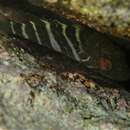Diagnostic Description
provided by Fishbase
Diagnosis: depth of body less than head length, depth 3.0-3.6 times in SL; head length 2.5-2.9 times in SL; interorbital area convex; preopercle angular, 3.6- large spines at the angle, lowermost directed ventrally; posterior nostril slightly bigger than anterior nostril; maxilla reaches nearly to vertical at rear edge of eye; pelvic fin origin below base of pectoral fins; rounded caudal fin; body scales ctenoid (Ref. 89707).Description: body rather elongate; lower jaw prominent; teeth of inner row depressible in both jaws; scales small, slightly imbricate and embedded in the thick skin (Ref. 57293).Coloration: ground colour dark reddish-brown or greyish-green, sometimes with more or less distinct lighter crossbars; 3-4 oblique whitish lines on cheeks and gill covers (Ref. 57293).
Life Cycle
provided by Fishbase
Most females change sex at about 9 kg, but smaller males (of 3 to 5 kg) are occasionally found. Total potential fecundity was estimated to range from 789,436 ova in a 44 cm SL fish of 2.2 kg to 12,589,242 ova in a 87 cm SL fish of 12.6 kg. In Tunisia, sex change occurs at 10 to 13 years (6 to 15 kg, 80 to 110 cm TL).
- Recorder
- Estelita Emily Capuli
Migration
provided by Fishbase
Oceanodromous. Migrating within oceans typically between spawning and different feeding areas, as tunas do. Migrations should be cyclical and predictable and cover more than 100 km.
Morphology
provided by Fishbase
Dorsal spines (total): 10 - 11; Dorsal soft rays (total): 14 - 16; Analspines: 3; Analsoft rays: 7 - 9
Trophic Strategy
provided by Fishbase
Voracious predator.
Biology
provided by Fishbase
Adults are found on rocky or mud-sand bottom; juveniles have been taken in coastal lagoons and estuaries (Ref. 5222, 57293). In the west African waters, diet comprise of fishes (58%), stomatopods (21%), crabs (10%), and cephalopods (10%). It is a protogynous hermaphrodite. The seasonal migration of the species off the coast of Senegal is influenced by the seasonal upwelling off Senegal and Mauritania. Utilized fresh and smoked (Ref. 9987). Highly esteemed in the market of West Africa (Ref. 5377).
Importance
provided by Fishbase
fisheries: commercial; aquaculture: experimental; gamefish: yes

